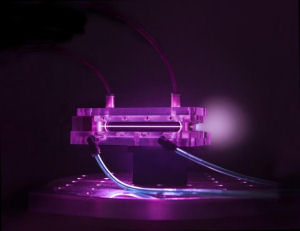8 December 2014
Table-top particle accelerator sets world record
by Will Parker
 Using a small, inches-long device, researchers have accelerated subatomic particles to the highest energies ever recorded from a compact particle accelerator. With further development, the Berkeley Lab researchers believe they can shrink traditional, miles-long accelerators to machines that can fit on a table.
Using a small, inches-long device, researchers have accelerated subatomic particles to the highest energies ever recorded from a compact particle accelerator. With further development, the Berkeley Lab researchers believe they can shrink traditional, miles-long accelerators to machines that can fit on a table.
The researchers sped up the electrons inside a nine-centimeter (4 inch) long tube of plasma to an energy of 4.25 giga-electron volts. The acceleration over such a short distance corresponds to an energy gradient 1,000 times greater than traditional particle accelerators and marks a world record energy for laser-plasma accelerators.
"This result requires exquisite control over the laser and the plasma," says Berkeley Lab's Wim Leemans, lead author on a paper describing the table-top accelerator in the journal Physical Review Letters.
Traditional particle accelerators, like the Large Hadron Collider at CERN, which is 17 miles in circumference, speed up particles by modulating electric fields inside a metal cavity. It's a technique that has a limit of about 100 mega-electron volts per meter before the metal breaks down.
The new work builds on a plasma-model first documented by Leemans and his team back in 2006. A pulse of laser light is injected into a short and thin straw-like tube that contains plasma. The laser creates a channel through the plasma as well as waves that trap free electrons and accelerate them to high energies. It's akin to how a surfer gains speed when skimming down the face of a wave.
The record-breaking energies were achieved with the help of the Berkeley Lab Laser Accelerator (BELLA), one of the most powerful lasers in the world. BELLA, which produces a quadrillion watts of power (a petawatt), began operation just last year.
"We're forcing this laser beam into a 500 micron hole about 14 meters away, " Leemans explains. "The BELLA laser beam has sufficiently high pointing stability to allow us to use it. The laser pulse, which fires once a second, is stable to within a fraction of a percent. With a lot of lasers, this never could have happened."
In order to accelerate electrons to even higher energies - Leemans' near-term goal is 10 giga-electron volts - the researchers will need to more precisely control the density of the plasma channel through which the laser light flows. In essence, the researchers need to create a tunnel for the light pulse that's just the right shape to handle more-energetic electrons. Leemans says future work will demonstrate a new technique for plasma-channel shaping.
Related:
Discuss this article in our forum
Fusion lab reports important boot-strapping milestone
Novel synchrotron X-ray generator could revolutionize security, medicine
Unfashionably early neutrinos trigger faster-than-light brouhaha
Source: DOE/Lawrence Berkeley National Laboratory
